Do you try to make ssambap or soup containing Doenjang but can’t process due to the absence of Korean Bean paste! Then not too worry, I listed four ideal and easy-to-find Doenjang substitutes for your favorite Korean recipes.
You just need a few adjustments and can eventually make anything used to make Doenjang. All have similar flavors and textures, like Korean bean paste. So keep scrolling through all details.
What is Doenjang? What is doenjang used for?
Doenjang is a Korean fermented soybean paste taste similar to Japanese miso paste. It has been used as a relish also base for making soup and stews such as doenjang jigae (soybean paste stew) and doenjang-jjigae (kimchi and soybean paste stew).
It is also common to make dipping sauces like gochujang (hot pepper paste), another popular spicy condiment for dishes like gyeran-jjim (steamed egg), and kimchi.
What can I use instead of a doenjang?
When I always run out the Korean soybean paste, always choose miso then alternatively any fermented bean paste in a 1:1 ratio. Also, you can use Natto and yellow bean paste to get a similar taste.
4 Ideal Doenjang Substitutes
1. Japanese miso paste- A perfect Substitute for Doenjang
Japanese miso paste is a traditional Japanese thick fermented soybean paste. It is widely used in various Japanese savory dishes, soups, sauces, and pickles.

Miso is often mixed with Dashi, miso soup. Miso has a balanced flavor with a sweet, salty, savory, beany, and earthy flavor.
You can use Miso paste 1:1 ratio for Korean Doenjang in any recipe calling for it.
Read More- Ideal Miso Substitutes Must Use
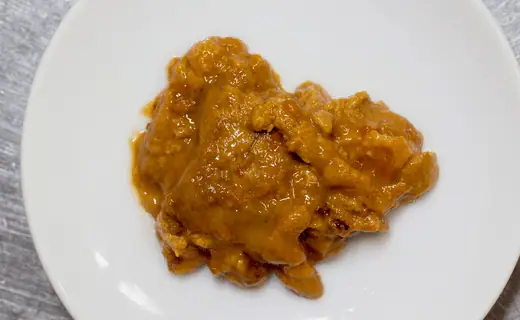
2. YELLOW BEAN PASTE- A Decent Alternative to Doenjang
Yellow bean paste is another similar fermented soybean paste popular in China. It is made from yellow soybean, salt, and water and then fermented.
Yellow soybean paste is typically added to noodles and soups. You can find any Asian grocery store. Use 1 tbsp yellow soybean paste for every tbsp Doenjang.
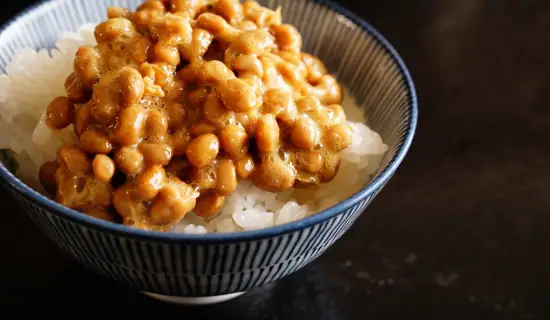
3. NATTO- Good Replacement for Doenjang/ Korean Soybean paste
Natto is another fermented food made from the whole soybean. It is typically consumed in breakfast. You can say canned soybeans.
It has a distinctly strong smell, so most people can’t take it; it is served with taro sauce, karashi mustard, and rice.

4. FERMENTED BEAN PASTE – Best Korean Bean Paste Substitute
If you don’t find anything to substitute for Korean fermented soybean paste, use any fermented bean paste instead. After all, Doenjang is a type of fermented bean paste.
Various beans can be used in fermented bean paste fava bean, broad beans, etc. But it has a similar taste to Doenjang.
Although fermented bean paste contains more salt than doenjang, check the taste before putting too much.
Read More- Substitute for Golden Musroom Soup

5. Gochujang
Gochujang is a traditional Korean fermented red chili paste similar to doenjang but spicy. It is a staple ingredient in Korean cuisine and is known for its rich, spicy, and slightly sweet flavor.
Gochujang is made by fermenting a mixture of chili peppers, glutinous rice, soybeans, and salt. The paste can vary in spiciness, depending on the type and amount of chili peppers used.
Gochujang is used in a wide variety of Korean dishes, such as bibimbap (a mixed rice dish), tteokbokki (spicy rice cakes), bulgogi (marinated grilled meat), and kimchi (fermented cabbage). It adds depth and heat to dishes and also contributes to the vibrant red color commonly associated with Korean cuisine.
In addition to its flavor, gochujang is valued for its nutritional benefits. It contains essential amino acids, vitamins, and minerals. Gochujang is also rich in capsaicin, a compound known for its potential health benefits, including pain relief and anti-inflammatory properties.
You can find gochujang in most Asian grocery stores or even online. It is usually sold in tubs or jars, and there are different brands and variations available. Gochujang can be stored in the refrigerator and has a long shelf life.
When using gochujang in cooking, it’s important to note that it is quite spicy, so you may want to adjust the amount based on your personal preference for heat. It can be used as a marinade, a dipping sauce, or as a seasoning in soups, stews, and stir-fries.
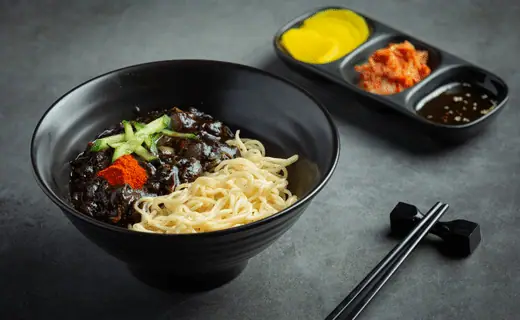
6. Fermented black beans
Fermented black beans, also known as salted black beans or douchi, are a popular ingredient in Chinese cuisine. They are made by fermenting black soybeans with salt and sometimes other seasonings.
The fermentation process gives the beans a distinct savory and pungent flavor.
Fermented black beans are commonly used as a seasoning in various Chinese dishes, particularly in stir-fries, sauces, and braised dishes. They add a depth of umami flavor and a slightly salty taste to the dishes they are added to.
To use fermented black beans, they are typically rinsed and soaked briefly to remove excess salt before being minced or mashed. They are then added to the cooking process, usually together with other ingredients like garlic, ginger, and chili peppers.
Some popular Chinese dishes that feature fermented black beans include Mapo Tofu (a spicy tofu dish), Black Bean Sauce Chicken, and Black Bean Shrimp. The beans can also be used in vegetarian or vegan dishes as a flavor enhancer.
Fermented black beans can be found in Asian grocery stores, usually in small plastic bags or jars. They have a long shelf life and can be stored at room temperature. When stored properly, they can last for months.
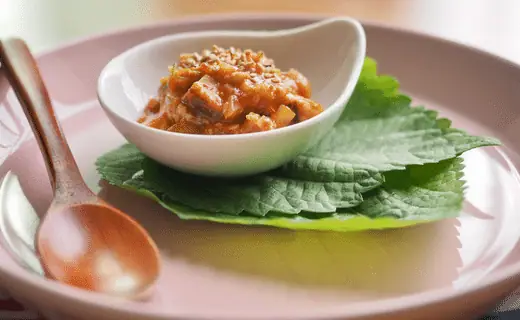
7. Ssamjang
Ssamjang is a popular Korean dipping sauce or condiment that is commonly used in Korean barbecue and wraps called ssam.
The name “ssamjang” literally translates to “wrap sauce” in Korean. It is a thick, savory, and slightly spicy sauce with a complex flavor profile.
The main ingredients in ssamjang are gochujang (Korean fermented red chili paste) and doenjang (Korean fermented soybean paste). These two fermented pastes form the base of the sauce and give it its distinct taste.
Gochujang adds spiciness and sweetness, while doenjang contributes a rich and earthy flavor.
In addition to gochujang and doenjang, ssamjang may also include other ingredients such as sesame oil, garlic, green onions, soy sauce, rice vinegar, and sugar. These additional ingredients enhance the overall flavor and balance the spiciness and saltiness of the sauce.
Ssamjang is typically served alongside grilled meat, such as samgyeopsal (pork belly) or galbi (marinated beef short ribs), in Korean barbecue restaurants. It is used as a dipping sauce for the grilled meat, adding an extra layer of flavor.
Ssamjang is also spread on lettuce or perilla leaves, which are then used to wrap the meat, along with other ingredients like rice, kimchi, and garlic.
You can find pre-packaged ssamjang in Korean grocery stores or make it at home using individual ingredients.
Homemade ssamjang allows you to customize the flavor to your liking by adjusting the proportions of the ingredients. It can be stored in the refrigerator for several weeks.
8. Korean soy sauce
Korean soy sauce, known as “ganjang” in Korean, is a staple condiment in Korean cuisine. It is a fermented sauce made from soybeans, wheat, salt, and water. Korean soy sauce has a distinct flavor and aroma that sets it apart from other types of soy sauce.
There are two main types of Korean soy sauce: Joseon ganjang and guk-ganjang. Joseon ganjang is traditionally brewed soy sauce, while guk-ganjang is a quicker version that undergoes a shorter fermentation process.
Joseon ganjang is typically made by fermenting a mixture of soybeans and wheat over a period of several months. The fermented mixture is then pressed to extract the liquid, which is filtered and aged to develop its flavor. This type of soy sauce has a deep, complex flavor with rich umami notes and a slightly sweet taste.
Guk-ganjang, on the other hand, is made by fermenting a mixture of soybeans, wheat, and salt for a shorter period of time, usually a few weeks.
It has a lighter flavor compared to Joseon ganjang and is commonly used in soups, stews, and other dishes where a milder soy sauce flavor is desired.
Korean soy sauce is used in a wide range of Korean dishes to add depth of flavor and enhance the overall taste. It is a versatile ingredient and can be used as a marinade, seasoning, or dipping sauce.
It is often combined with other ingredients like garlic, ginger, sesame oil, and vinegar to create various sauces and dressings.
You can find Korean soy sauce in Korean grocery stores or Asian markets. It is available in different brands and varieties, including both traditional and commercial options.
It is usually sold in bottles or plastic containers and can be stored at room temperature.
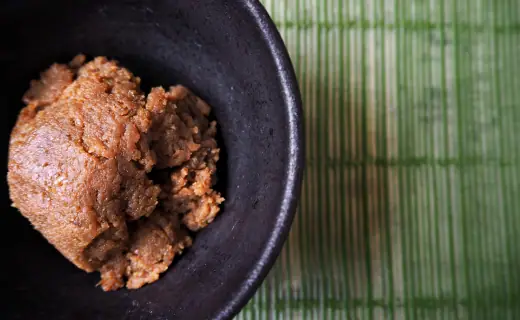
9. Doubanjiang
Doubanjiang, also known as douban or broad bean chili paste, is a spicy and salty fermented condiment commonly used in Sichuan cuisine, regional cuisine of China often confused with Doenjang as it seems the same.
It is made from broad beans, chili peppers, salt, and sometimes other ingredients like soybeans, wheat flour, and spices.
Doubanjiang has a distinct and complex flavor profile. It is characterized by its intense umami taste, spiciness, and slightly fermented and salty tang. The combination of broad beans and chili peppers gives it a unique savory and spicy kick.
The process of making doubanjiang involves fermenting the broad beans and chili peppers together with salt in large earthenware jars.
The mixture is traditionally left to ferment for months or even years, allowing the flavors to develop and intensify. The final product is a thick, dark reddish-brown paste with a coarse texture.
In Sichuan cuisine, doubanjiang is a key ingredient and is used in a variety of dishes to add depth and complexity. It serves as the foundation for iconic Sichuan dishes such as Mapo Tofu, Kung Pao Chicken, and Twice-Cooked Pork.
Doubanjiang is also used in stir-fries, hot pots, noodle dishes, and even as a dipping sauce.
When using doubanjiang in cooking, a little goes a long way due to its intense flavor. It can be added directly to stir-fries or used as a seasoning in marinades and sauces. It’s important to note that doubanjiang can be quite spicy, so adjust the amount to your desired level of heat.
Doubanjiang is available in many Asian grocery stores, particularly those specializing in Chinese ingredients. It is typically sold in jars or plastic containers.
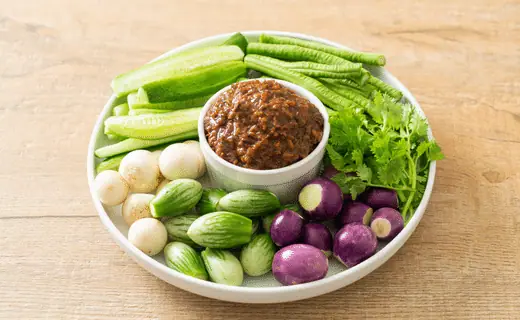
10. Thai fermented soybean paste/ tao jew
Thai fermented soybean paste, also known as tao jeow or tao jiew, is a traditional condiment used in Thai cuisine. It is made by fermenting soybeans with salt and other ingredients, resulting in a rich, savory, and slightly tangy flavor.
Tao jeow is typically dark brown in color and has a thick and paste-like consistency. It is commonly used as a flavor enhancer and seasoning in Thai dishes, adding depth and complexity to the flavors.
It is particularly popular in northeastern Thai cuisine, known as Isan cuisine.
In Isan cuisine, tao jeow is often used as a key ingredient in dishes such as larb (a minced meat salad), som tam (green papaya salad), and various grilled meats. It can also be incorporated into dipping sauces, marinades, stir-fries, and soups.
The exact recipe for tao jeow can vary, and different regions or households may have their own versions. Apart from soybeans and salt, additional ingredients like garlic, chili peppers, and various herbs and spices can be included in the fermentation process to add different layers of flavor.
Tao jeow is typically sold in jars or containers in Thai grocery stores or Asian markets. It is worth noting that the level of saltiness and flavor intensity can vary between brands, so you may want to taste and adjust the amount used in your recipes accordingly.
When using tao jeow, a little goes a long way due to its concentrated flavor. Start by adding a small amount and gradually increase to achieve the desired taste.
It is a versatile condiment that can add depth to various Thai dishes and can be a delightful addition to your culinary repertoire if you enjoy Thai cuisine.
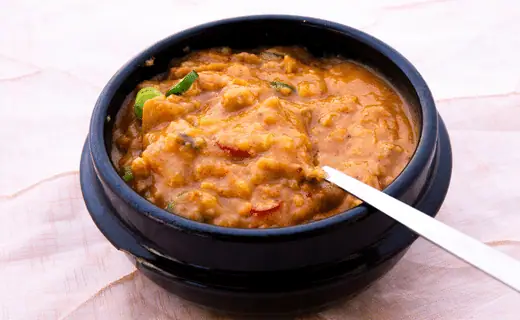
11. ground bean sauce
Ground bean sauce, also known as fermented bean sauce or brown bean sauce, is a savory and pungent condiment commonly used in Chinese cuisine. It is made from fermented soybeans, wheat flour, and sometimes other ingredients like salt, sugar, and spices.
The process of making ground bean sauce involves fermenting soybeans, typically with the addition of wheat flour, in a controlled environment. This fermentation process gives the sauce its distinct flavor and aroma.
The fermented soybeans are then ground into a paste or sauce-like consistency.
Ground bean sauce has a deep and rich umami flavor with a slightly salty and earthy taste. It adds complexity and depth to dishes. It is commonly used as a seasoning in stir-fries, braises, and marinades. It is particularly popular in northern Chinese cuisine.
In Chinese cooking, ground bean sauce is often used in dishes such as Mapo Tofu, Twice-Cooked Pork, and various stir-fried vegetable dishes. It can be combined with other ingredients like garlic, ginger, chili peppers, and soy sauce to create flavorful sauces and seasonings.
You can find ground bean sauce in Chinese grocery stores or Asian markets. It is typically sold in jars or plastic containers. Some brands may offer different variations, such as spicy or non-spicy versions, allowing you to choose according to your preference.
When using ground bean sauce in your recipes, start with a small amount and adjust according to your taste preferences. It is a potent ingredient, so a little can go a long way in terms of flavor. You can store it in the refrigerator after opening to maintain its freshness.
Ground bean sauce is a versatile condiment that adds a unique savory note to Chinese dishes, and it can be a great addition to your culinary repertoire if you enjoy Chinese cuisine.
Doenjang VS Ssamjang
What’s the difference between doenjang and ssamjang? For a lot of Korean dishes, like kimchi jjigae and kimchi bokkeumbap, you’ll need both of them to make the dish taste right.
Both doenjang and ssamjang are made with doenjang, but they’re two very different sauces.
What’s doenjang?
Doenjang is a kind of Korean soybean paste. It’s fermented with rice, wheat bran (which gives it its brown color), and salt. Doenjang is used often in Korean cooking to give flavor to stews, soups, side dishes, etc.
What’s ssamjang?
Ssamjang is the combination of doenjang, gochujang (red chili pepper paste), and gochugaru (red chili pepper flakes). It’s a great accompaniment for grilled meat.
What dishes use doenjang and ssamjang?
Doenjang is used in soups, stews, and some side dishes. Ssamjang is used as a dip for grilled meat, also known as ssam or ssambap.
Can you make ssamjang without doenjang?
Yes, you can make ssamjang without doenjang if you use miso. If you make ssamjang with miso, it’s called miso ssamjang.
Doenjang VS Ssamjang – conclusion
Both doenjang and ssamjang are made with doenjang. They’re two very different sauces, but it’s difficult to say which one you should use for a dish.
You can combine the two to add flavor to your side dishes and grilled meat.
How to store doenjang
What I like most about doenjang (soybean paste) its distinctive flavor and aroma. No other food tastes like doenjang.
Doenjang is the foundation of kimchi (traditional Korean fermented vegetables) and stews, such as doenjang jjigae (soybean paste stew) and doenjang jjajangmyeon (soybean paste noodles).
Doenjang is quite hearty, so it doesn’t require much care after opening the package, but some of you might be wondering, “How long do I have to keep it after opening?”
Just like soy sauce and other condiments, doenjang (Korean soybean paste) can also be stored for a long time in the refrigerator.
Read More- Best Kimchi Alternatives and Ideal Fish Sauce Replacement in Kimchi
Doenjang vS Miso
Doenjang and miso are two types of soybean paste used in Korean and Japanese cuisine, respectively.
They are both manufactured from fermented soybeans, although their flavors and textures differ.
Doenjang is salty and slightly sweet, while miso is earthy and slightly salty and sour.
Korean miso is typically made in the town of Andong in Gyeongsangbuk-do, an area known for its doenjang.
It is a thicker paste with a stronger flavor than its Japanese counterpart and is often used in making soups, stews, and dipping sauces.
Spicy bean paste substitutes
I like to use a spicy bean paste substitute in my cooking. I usually use either Sambal Oelek or Sriracha sauce. They’re both very flavorful and add a lot of heat to dishes. However, this time I thought of using something different.
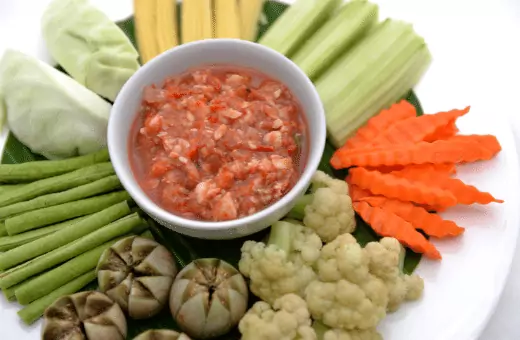
Chilli garlic sauce is a very common condiment in Sichuan cuisine, and it’s also one of my favorite sauces to use with steamed vegetables and dumplings.
There are many similar products on the market, most notably – Sambal Oelek, which is made from spicy red jalapeño peppers.
The one I used for this dish is made from red chilies and contains no preservatives, so it’s not as fiery as the Sambal Oelek. It turned out to be a perfect substitute.
Spicy bean paste substitute is a name of bean paste that Koreans eat. It’s made with soybean powder, sugar, hot pepper flakes, etc.
If you are familiar with Japanese miso soup called “miso shiru,” it has a kind of savory and salty taste, but “kongnamul shigae” (Korean spicy bean paste substitute) has a sweet and spicy flavor.
What is the best Doenjang brand?
1. Q-RAPHA TRADITIONAL KOREAN DOENJANG- It is gluten-free and natural taste.
2. SEMPIO 100 DAYS DOENJANG
Best ways to use doenjang
Best ways to use doenjang (Korean miso paste)
Doenjang is one of the most essential ingredients in Korean cooking. With its tangy, savory flavor, doenjang can be used to make most Korean dishes.
It’s one of the reasons Koreans adore doenjang. In addition, doenjang can last for a very long time without going bad.
Doenjang sitting on a Korean kitchen shelf or in a Korean fridge for 10 years or more is not an uncommon sight. In fact, doenjang from the ’50s and ’60s are still around because Koreans have kept them around as heirlooms.
But doenjang can go bad if it’s exposed to heat or sunlight for too long; keep it in mind while you make your purchase.
Here are some of the best ways to use and enjoy doenjang:
1. SOUP – Spicy doenjang soup
Doenjang jjigae is one of the most famous soups in Korea. It’s quick to make, healthy, and has a unique flavor that you won’t find in any other type of soup.
2. TANG
Doenjang jjigae is thicker than most soups, but it’s definitely not considered a stew. When you order doenjang jjigae at a restaurant, you’ll usually be served with a bowl of rice with the soup in a small bowl on top.
· You can use your spoon to break up the chunks of doenjang and mix it all up, so you get both the soup and rice at once.
3. STEW (Jjigae)
Doenjang jjigae is not a stew. It’s closer to a soup because the consistency is quite liquidy. If you add too much water, your doenjang jjigae will become more soup than a stew.
4. STIR-FRY (Jokbal)- Doenjang jjim
Doenjang adds a nice flavor and aroma to all sorts of stir-fries and stews. Stews and stews flavored with doenjang are often called jokbal or jjim because braised dishes give off a good jokbal fragrance (Jokbal is actually the term for braised pig trotters).
5.BAP (Bap)- Doenjang bap (Doenjangbap)
The thing about doenjang is that it’s so tasty, it can actually be eaten by itself. When you want a quick meal that’s inexpensive and filling, doenjang bap or doenjang jjigae with rice is the perfect dish for you.
6. JEON (Jeon)- Doenjang jeon (Jjimjeon)
When you go to a Korean restaurant, there’s a chance that you’ll be served either seafood or meat as an appetizer. When it comes time to make the jeon (pancake), they will most likely use doenjang as their main ingredients.
Wrap Up On Substitute for Korean Soybean Paste Doenjang
Doenjang substitutes are Korean condiments that can be used to serve as soy sauce or miso soup for those who don’t eat meat.
The article discusses the ingredients and how to use doenjang substitutes. Still, it doesn’t mention any health benefits of using this substitute instead of soy sauce or miso soup.
I hope this will help to find out the right Doenjang replacements.
FAQs Related to (Doenjang Korean Soybean Paste)
Q1. Substitute doenjang for miso
Yes, you can substitute doenjang with miso. However, it will not be an exact substitution because the taste and flavor will differ.
One of the main differences is that miso contains salt, whereas doenjang does not. Doenjang is earthier and full of umami, while miso is saltier and less intense.
Q2. Can i substitute ssamjang for doenjang?
No, Ssamjang is a thick spicy paste made from doenjang, gochujang, garlic, seasoning spices, onion, and other ingredients.
Q3. Is gochujang the same as doenjang?
No, they are different. While gochujang is a fermented paste made of chili powder (gochugaru), rice (or wheat), and salt, doenjang is also a soybean-based paste but not fermented. It’s akin to miso in taste and use – think miso soup.
Q4. Is doenjang the same as miso?
No. The two products resemble one another but are actually different by nature. Miso is fermented with a fungus (Aspergillus oryzae). Doenjang is fermented with a bacterial culture (Aspergillus oryzae and Bacillus subtilis).
Most doenjang sold in Korea is made from soybeans, salt, and ‘kongnamul’ (the sprouted seeds of a legume).
On the other hand, Miso is a Japanese seasoning made using a larger variety of ingredients, including fermented soybeans, with salt and kōji rice and barley and is fermented over a longer period. Miso is usually lighter in color and has a more complex flavor than doenjang.
Typically, miso is salty, but its flavor and aroma depend on the ingredients Doenjang is Sweet and salty.
Q5. Can I substitute Gochujang for doenjang?
Gochujang is a paste made from chili powder, glutinous rice flour, salt, and fermented soybeans. It forms the base for many Korean dishes.
It is the essential ingredient in making gochujang-based stews such as buddae jjigae (army stew) and kimchi jjigae.
It is also mixed with other seasonings to make a dipping sauce for naengmyeon (buckwheat noodles) and ganjang (soy sauce).
I’ve recently come across a question from a reader asking whether gochujang and doenjang can be substituted for each other.
The answer is that the two have completely different flavors, textures, and colors. It is difficult, if not impossible, to substitute one for the other.
For this reason, I wouldn’t recommend trying to use gochujang as a substitute for doenjang.
However, certain dishes are made with equal parts of both gochujang and doenjang. In this case, you can substitute one for the other.
I’ve also seen recipes calling for only gochujang. In this case, I would recommend doubling the amount of doenjang as a substitute.

